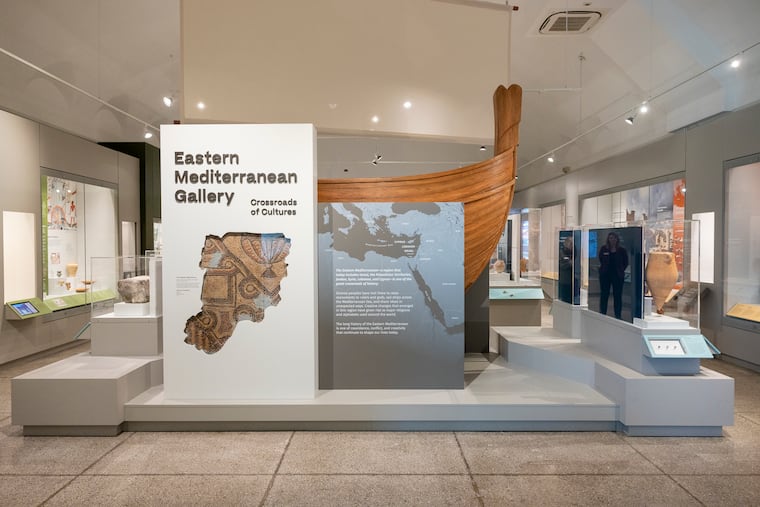A new gallery at Penn Museum relooks at Eastern Mediterranean history
“Crossroads of Culture,” the gallery, opens on Nov. 19

The popular imagination often wholly portrays the eastern Mediterranean as politically fractured and war-laden. It is a representation that Penn Museum counters in its new gallery, “Crossroads of Culture,” which highlights the social, commercial, and political innovations that originated from the region.
Charging through the entrance of the exhibit is the hull of a cargo ship that sank in the Mediterranean Sea in the 14th century BCE. It’s a replica brimming with real artifacts excavated from the shipwreck, which make up a part of the gallery’s nearly 400 pieces spanning a period of 4,000 years. Pieces of pottery and precious metals displayed in the hull firmly establish the importance of the region — made up of Palestine, Jordan, Israel, Lebanon, and Syria — as a promoter of international commerce.
Interactive features throughout the gallery tease out the connection between the area’s contributions, such as the world’s first alphabet, and its application in our day-to-day lives. Stationed near a cuneiform clay tablet made in 500-400 BCE and excavated in Iraq, is a digital tablet where visitors can track how the Egyptian hieroglyph for ox was adapted by the Canaanites 4,000 years ago into a simpler alphabet that led to the Phoenician alphabet we use today.
“Culture of Crossroads,” which opens today, is the only gallery in North America that contextualizes excavations within the region as a colonial practice. A digital screen in the gallery shows a map of the eastern Mediterranean carved up by the British and French governments after WWI, as part of the Sykes-Picot agreement. It was a colonial claim to the region that opened the possibility for foreign excavation teams, including from Penn Museum, to enter the region searching for antiquities. The excavations that built up the museum’s collection occurred from 1921 through the 1980s, during “six decades of contentious, violent intervals, including a world war, along with the drawing and redrawing of borders” in the eastern Mediterranean, said co-curator Eric Hubbard in a statement.
Museums often overlook the contributions of local community members that lead to an excavation’s success and, as a result, distort the public memory of a region by heralding archeologists as explorers in the unknown. Tucked in a corner of the gallery are three manila folders that provide insight into the contributions of community members. These are labeled: Beth Shean, Kourion, and Gibeon — the names of three major excavations led by Penn Museum throughout the eastern Mediterranean.
The folders contain reproductions of primary documents that specify the relationship between Penn’s excavation team and community members in the region who, in many cases, did the actual excavating and administrative work needed to get the artifacts to Philadelphia. One wage record dated 1960 shows that the Penn Museum team paid local farmers in Jordan the equivalent of $10 a day to dig in Gibeon. A receipt to local landowners shows the damage to crops and land done by the work, signifying the team’s disruptive presence.
One letter from Asia Hallaby, a local volunteer with the Gibeon excavation, specifies how the artifacts from that excavation could not have gotten to Philadelphia without her help. Hallaby was left to ship the artifacts back “once the foreign archaeologists had gone home to their families and university responsibilities,” according to an email to The Inquirer from Virginia Hermann, co-curator of the gallery.
As part of the gallery’s two-day celebration today and Sunday, Penn Museum’s archives department will give visitors access to more photos and other primary documents that continue to tell the untold stories behind the excavations’ success at Kourion and Beth Shean.
The gallery pushes against the stereotypical always-at-war portrayal of the eastern Mediterranean by showcasing antiquities acquired through disruptive and exploitative practices. Providing access to the documents detailing those practices acknowledges a harsh reality: “Archeology in this region doesn’t just happen in an ivory tower, it’s also involved in practices of empire building,” said Lauren Ristvet, the lead curator for the gallery, in an interview with The Inquirer.
“Crossroads of Culture” sets the record straight on how the region served as a nexus for commercial activity and social innovation, while also addressing the colonial enterprise that prevented that recognition from being given in the first place.